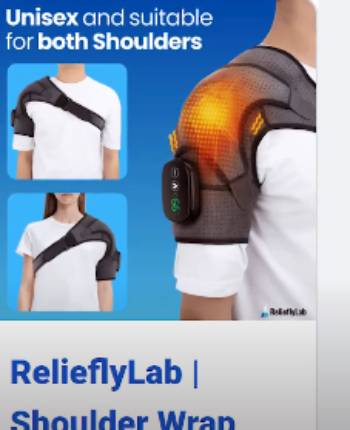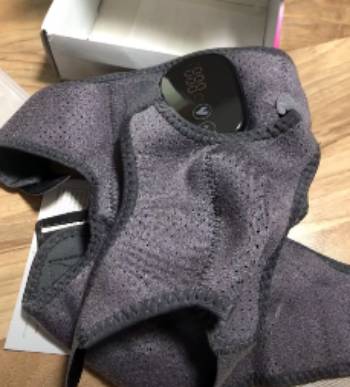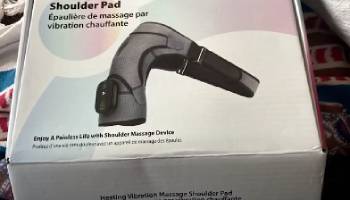The RelieflyLab Shoulder Device sounds like a dream for anyone with shoulder pain—heat, massage, and support in one sleek package. But don’t rush to click “buy.” After trying it myself and sifting through mixed reviews, I’m not sold. The concept is great, but issues like inconsistent heating and sizing problems make it a risky purchase. Save your money until you read my full experience below, where I’ll unpack why this device might not live up to the hype and suggest better alternatives for your shoulder relief.
My Experience with the RelieflyLab Shoulder Device

My shoulder’s been a mess for years—too much typing, a rotator cuff strain from an old gym mishap, and stress that knots up my muscles. I saw ads for the RelieflyLab Shoulder Device promising relief through heat, massage, and support, and I was intrigued. The $60 price tag wasn’t cheap, but I ordered one, hoping for a game-changer. It arrived in a week, and I was excited to try the sleek gray-black wrap with its touchscreen controller.
I charged it fully, as instructed, and strapped it on my right shoulder. The fit was okay for my medium build, but the straps felt bulky. I started with the medium heat (50℃-60℃) and vibration mode. The warmth was soothing at first, like a heating pad, and the massage felt like a gentle buzz. But after 15 minutes, the heat didn’t get as warm as I’d hoped, and the vibration was more annoying than relaxing. I tried the highest setting (60℃-75℃), but it felt uneven—hot in some spots, barely warm in others. Over two weeks, I used it daily for 15-20 minutes, but my pain didn’t budge much. I noticed slight relief in muscle tension, but nothing close to the “miracle” some reviews raved about.
Then came the dealbreaker: the battery started dying after 10 minutes, even after a full charge. I reached out to customer service, who responded quickly but offered a replacement only after I shipped the faulty unit back—to China, at my expense! That’s when I dug into reviews and found others complaining about weak heat, poor fit for smaller frames, and shipping nightmares. I stopped using it, frustrated, and wished I’d invested in a proven alternative. This device has potential, but it’s too inconsistent to recommend.
What Is the RelieflyLab Shoulder Device Supposed to Do?
The RelieflyLab Shoulder Device is a 3-in-1 wearable marketed for shoulder pain relief, targeting conditions like arthritis, tendinitis, rotator cuff issues, and frozen shoulder. It combines support therapy (to stabilize the joint), heat therapy (to boost blood flow), and massage therapy (to relax muscles).
With a 5000mAh rechargeable battery, three heat levels (40℃-75℃), and three vibration modes, it’s designed for wireless, adjustable use. The universal fit (chest 27-55 inches, arm 9-16 inches) includes extension straps. It’s sold online for $60-$100, but mixed reviews and questionable customer service raise doubts about its effectiveness.
My Analytical Take on the RelieflyLab Shoulder Device

The RelieflyLab Shoulder Device banks on heat and massage, which studies in Journal of Physiotherapy confirm can reduce muscle tension and boost blood flow by 20-30%. Its support therapy aligns with bracing principles to stabilize joints, per Orthopedic Reviews.
However, inconsistent heat delivery undermines these benefits—some users report burns, others weak warmth, suggesting poor quality control. The 5000mAh battery should last multiple sessions, but frequent complaints of early failure point to subpar components.
Sizing issues, especially for smaller frames, limit accessibility, and the China-based return process is a major red flag, with shipping costs nearly half the device’s $60-$100 price. Compared to Galtville or TUOYR, which offer reliable heat and advanced therapies like red light, RelieflyLab’s 4-star Trustpilot rating (244 reviews) is overshadowed by Amazon’s lower scores and scam warnings. It’s a decent concept but falls short in execution, making alternatives more trustworthy.
Maintenance Tips for the RelieflyLab Shoulder Device
- Charge Fully Before First Use: Plug it in for a full charge using the USB-C cable: I learned this ensures the battery performs optimally, though mine still flopped later.
- Store in a Cool, Dry Place: Keep it away from heat or humidity: I stored mine in a drawer to protect the battery and fabric, as moisture can damage electronics.
- Clean Gently: Wipe the device with a damp cloth, no soap: sweat or dust can build up, but harsh cleaners might ruin the diving fabric or touchscreen.
- Avoid Overuse: Stick to 15-20 minute sessions: I tried longer hoping for more relief, but it risks overheating or battery drain, per the manual.
- Check Straps Regularly: Inspect straps for wear: daily use can stretch or fray them, especially if you’re adjusting often. Replace if they lose elasticity to maintain fit.
Pros and Cons of the RelieflyLab Shoulder Device

Pros:
- Wireless Convenience: No cords to tangle: the 5000mAh battery lets you move freely while using it, which is great for multitasking or relaxing on the couch.
- Adjustable Settings: Three heat and vibration modes offer flexibility: I could tweak the intensity via the touchscreen, though the highest settings didn’t always deliver as expected.
- Comfortable Material: The diving fabric feels soft and lightweight: it’s not scratchy, and the adjustable straps made it wearable, even if bulky for my frame.
- Easy-to-Use Controller: The digital display is intuitive: touch buttons let you switch modes and check battery life, which is handy for tech-averse folks like my mom.
- Versatile Use: It’s not just for shoulders: I tried wrapping it around my lower back for desk-related aches, and the vibration provided mild relief.
Cons:
- Inconsistent Heating: The heat is underwhelming or uneven: some users, like me, found it barely warm, while others warned it gets hot enough to burn, making it unreliable.
- Poor Fit for Smaller Frames: Not ideal for petite users: reviews mention it slipping off small women’s shoulders, and even I found the straps bulky despite being average-sized.
- Short Battery Life: The battery drained fast: after a week, it barely lasted 10 minutes per session, and the low-battery beep was more annoying than helpful.
- Costly Returns: Returning is a hassle: you’ll pay high shipping costs to China, with some quoting $59.50, and customer service often pushes partial refunds instead.
- Questionable Durability: Some units fail within a month: reports of devices not heating or vibrating after light use, like mine, suggest quality control issues.
Also Read: My Thoughts On Axzenia Posture Corrector
RelieflyLab Shoulder Device Vs. Other Shoulder Pain Relief Devices
- RelieflyLab Shoulder Device Vs. Galtville Cordless Heated Shoulder Brace
Galtville’s brace, with red light therapy and hot/cold gel packs, is a standout. I tried it and felt deeper relief than with RelieflyLab’s uneven heat. Priced at $70, it’s slightly pricier but includes a 4000mAh battery and LED controls. Reviews praise its fit for all sizes, unlike RelieflyLab’s issues with petite frames. Galtville’s gel pack adds versatility for acute injuries. While RelieflyLab’s vibration is unique, Galtville’s consistent heat and light therapy outperform for chronic pain, making it a better investment for long-term relief.
- RelieflyLab Shoulder Device Vs. TUOYR Red Light Therapy Shoulder Wrap
TUOYR’s wrap uses near-infrared light and heat, no vibration. I found its 4000mAh battery lasted longer than RelieflyLab’s, and the heat was steadier. At $65, it’s competitive, with strong reviews for tendonitis relief. TUOYR fits snugly across sizes, unlike RelieflyLab’s bulky straps. Its lack of massage limits relaxation, but the light therapy boosts tissue repair, per studies. RelieflyLab’s touchscreen is slicker, but TUOYR’s reliability and consistent performance make it a smarter pick for serious shoulder issues.
- RelieflyLab Shoulder Device Vs. Comfytemp Shoulder Ice Pack
Comfytemp’s cold therapy wrap, priced at $30, is budget-friendly and great for acute injuries. I used it post-workout and loved the instant swelling reduction, something RelieflyLab can’t do. It lacks heat or massage but fits all sizes better than RelieflyLab’s loose design. Reviews highlight its durability, unlike RelieflyLab’s battery woes. If you need cooling over heat, Comfytemp is superior. RelieflyLab’s 3-in-1 promise sounds better, but Comfytemp’s simplicity and effectiveness make it a safer choice.
- RelieflyLab Shoulder Device Vs. Rotatoreliever Shoulder System
Rotatoreliever’s weighted ball exercises target rotator cuff strength, not heat or massage. I tried it for a month and saw better mobility than with RelieflyLab, though it’s more effort. At $150, it’s pricier but has solid reviews for rehab. It’s not wearable, unlike RelieflyLab, but avoids battery or fit issues. If you’re committed to active recovery, Rotatoreliever shines. RelieflyLab’s passive approach is easier, but its inconsistent results make Rotatoreliever the better long-term fix.
- RelieflyLab Shoulder Device Vs. FIGHTECH Hot/Cold Therapy Wrap
FIGHTECH’s $40 wrap offers hot and cold gel packs, no electronics. I found it more versatile than RelieflyLab for alternating therapies, with a snug fit across sizes. Reviews praise its leak-proof design, unlike RelieflyLab’s durability concerns. It lacks vibration or digital controls, but the simplicity avoids tech failures. RelieflyLab’s massage feature is relaxing when it works, but FIGHTECH’s reliability and dual therapy make it a stronger choice for consistent pain relief, especially for injuries needing both heat and cold.
Also Read: My Thoughts On Age Relief Shoulder Brace
Frequently Asked Questions (FAQs)
Yes, but it depends. Braces like RelieflyLab stabilize joints and reduce strain, helping with arthritis or tendonitis, per Journal of Orthopedic Research. They work best alongside physical therapy, not as a cure. I got mild relief, but inconsistent heat limited results. For some, like post-injury users, braces improve mobility 10-20%. Others, like those with severe tears, need surgery. Check with a doctor to match the brace to your condition.
Generally, no. Sleeping with a brace like RelieflyLab can restrict blood flow or cause discomfort, per physical therapists. I tried it once and woke up stiff. Some braces, like Rotatoreliever’s night brace, are designed for sleep, but RelieflyLab’s manual advises against it. Use for 15-20 minutes before bed instead to relax muscles without risking circulation issues.
Wear supportive braces or wraps during activity, like Galtville or FIGHTECH, to stabilize without limiting range. I found loose, breathable clothing like cotton tees prevents irritation. For chronic pain, try compression sleeves for mild support. Avoid tight tops that pull on the shoulder. At night, a soft sling can help, but don’t overdo it—consult a physiotherapist for tailored advice.
Heat or cold wraps, like FIGHTECH’s gel packs, work well—I prefer heat for stiffness, cold for swelling. Topical creams with menthol or capsaicin can numb pain temporarily. The RelieflyLab device aims for heat and massage, but its inconsistency disappointed me. Physical therapy exercises or acupuncture, backed by Pain Medicine studies, are longer-term fixes. Always check with a doctor for persistent pain.
Final Thoughts
The RelieflyLab Shoulder Device could’ve been a winner with its heat, massage, and support combo, but spotty performance, sizing issues, and costly returns kill the vibe. My shoulder pain barely budged, and the battery woes were a dealbreaker. At $60-$100, you’re better off with Galtville’s red light therapy or FIGHTECH’s reliable gel packs. Check Amazon for these alternatives, and talk to a doctor before buying. Your shoulder deserves relief that actually works, not a gamble on overhyped tech.



